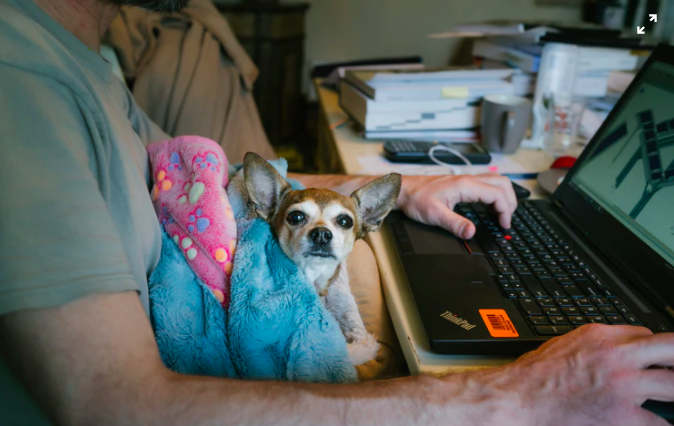
Alex Mitchell, Chief Product Officer at ICX Media, the author of Building Digital Products and Disrupting Yourself.
Blog: https://medium.com/@Amitch5903
Website: http://www.alexmitchell.co/
One of the main reasons I write is because it forces me to research, it forces me to learn, and it forces me to coalesce and refine my ideas down to their simplest, most crisp form before sharing them with the world.
Today, I became a remote Product Manager (well really, a remote CPO) for ICX Media as a result of the Coronavirus/COVID-19. Similar to many other tech companies, we’re going fully remote for the next ~2 weeks and evaluating from there.
As I’ve discussed with prior blog posts (see: Build a Kickass Remote Dev Team), I’m no stranger to working with distributed teams. Half of the ICX Media team is remote and Bullseye, a business I co-founded, is completely distributed, from our engineers in Pakistan to our designer in Maryland, to our Advisors all across the United States and the UK.
But, I’ve always been the person in the office…
For this blog post, I’m sharing all of the things I’ve learned, and continue to learn, about being a Great Remote Product Manager. Whether you’re remote currently or aspire to be remote in the future, I hope there are at least a few things you can learn from my experience.
Great Remote Product Managers
Leverage Slack/Microsoft Teams/Chat Responsibly

Great Product Managers are translators, processors, and conduits of information. As a fully remote PM, it’s incredibly tempting to take the information you just received from one source (let’s say your CEO) and disseminate it to others (let’s say your engineering team) instantaneously via chat. While in some limited cases, this could be a good decision, in most, it will be highly disruptive and often very confusing.
Your engineering team will undoubtedly have questions, they could easily have a misunderstanding of the requirements/goals, and you could very likely be missing information because you simply tried to communicate too quickly.
Chat has made it far too easy for PMs to simply be a conduit of information. Great Remote PMs absorb information from multiple sources, process it, and then decide on the best ways to communicate to their teams. It’s about the quality of communication, not the quantity.
Quick Video Calls Are Almost Always Worth It
Even as a non-remote PM, I’ve often caught myself in a Slack conversation that’s gone back and forward 10 times or more with my engineers or my designers.
At this point, and ideally sooner, I almost always suggest a quick video call. So much nuance and information is lost in chat that I’ve found a video call is often at least 5x more effective per minute of time spent. Great Remote PMs don’t waste time with endless chat threads.
Prepare for Meetings

It may be tempting for remote PMs to prepare less for meetings if they haven’t created the right home environment to engage “work mode” (more on that later).
Great Remote PMs still prepare for meetings and standups with as much energy and passion as they would for an in-person meeting with their full team. Additionally, they are just as clear with their teams about the purpose of the meetings and their goals for outcomes.
Take Breaks for Lunch and Find a Balance of Work

It’s often easy to lose track of time and to become absorbed in your work as a remote PM. Create breaks in your schedule (even add blocks of time on your calendar) to ensure you get time to walk around, grab a snack, eat lunch, etc.
It may sound silly, but with no one in your home getting up and grabbing lunch, you may forget to and it will bring down your quality of output and communication. No one thinks well when they are hungry!
Leverage Quiet Time to Plan
Product Managers are one of the most interrupted people in the office. Whether it’s your CEO, sales team, client services team, engineers, designers, or other PMs, PMs have a lot of people to communicate with both informally and formally!
As a Remote PM, you still will have many forms of communication and information coming your way, but you’ll naturally have more quiet time with no one leaning over your desk or tapping you on the back to ask a question.
Take advantage of this quiet time to plan the next phases of your projects, to plan your next quarter’s priorities, and even to re-evaluate your competitive position. Need more ideas? Check out my related post on how the Best PMs handle downtime:
https://medium.com/swlh/how-the-best-product-managers-handle-downtime-fb3869c7c01b
Get Out of the House!

Similar to how you may find yourself forgetting to eat lunch as a newly remote PM, you may also forget to leave your house.
I’d highly recommend finding a few great out-of-home work locations (coffee shops, coworking spaces) that you can bounce between as you need to change up your environment.
Meet With Their Teams Periodically In The Real World
Going remote doesn’t have to mean being remote 24/7.
Whether it’s doing sprint planning in-person every 2 weeks, having a monthly in-person team event, or even meeting quarterly for a big offsite event, great remote PMs and great remote teams find a way to make in-person meetings and connections happen.
Humans are fundamentally social beings and having this level of informal and in-person engagement still is very valuable!
Bad Remote Product Managers
“Hover” Over Teams on Chat and Over-Participate
Define clear goals and clear requirements and get out of the way. As a Great Remote Product Manager, you should continually repeat these goals and requirements so they are well understood by the team as more organic repetition is lost in the digital world.
Bad Remote Product Managers have to interject in every single conversation that their team has on Slack and over-participate, meaning they share information that is unhelpful or confusing or out-of-their-skillset.
Are Unavailable

Great Remote Product Managers need to be highly available for clarification questions, prioritization questions and need to continually reinforce important goals.
Bad Remote Product Managers are often unavailable to answer these key questions and, because of this, their teams have slowed progress and can start to diverge from key goals.
Don’t Respect Other’s Schedules
With remote work, the boundaries between work and life can often get blurred. While it may be tempting to reach out to a team member via chat early in the morning, late at night, or on the weekend because you’re both at home, this type of engagement should be very very rare and only reserved for the most critical of communications.
Bad Remote Product Managers don’t respect these boundaries and other’s schedules and think only about their time.
Don’t Maintain a Workspace or Professionalism at Home
It’s easy to roll out of bed minutes before a meeting when you’re working at home and it’s also easy to wear sweatpants 24/7.
Bad Product Managers don’t maintain the same levels of professionalism at home as they do in the office.
The problem isn’t the clothes being too casual, it’s that this casual attitude continues to blur the line between life and work and very often cascades into a casual approach to goals, objectives, and planning as well.
How Have You Successfully Worked as a Remote Product Manager?
I’d love to hear what you’ve learned as I wade into a full-time remote PM/CPO role (at least for a few weeks!) Please share with me in the comments below!
Thanks for reading! If you’re enjoying this post, I know you would enjoy my 2 brand new courses on Product Management.
Whether you’re an aspiring Product Manager or looking to level up, I know you’ll learn a LOT from the >50 hours of the course content I’ve assembled.
If you prefer books, I think you’d also enjoy Disrupting Yourself (how to succeed in the new economy) or Building Digital Products.
- Disrupting Yourself Special Offer
- Building Digital Products (New 2nd Edition!)
